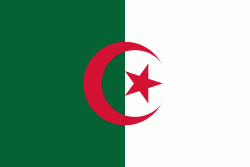Biskra
Biskra (بسكرة; Tibeskert; Latin Vescera) is the capital city of Biskra Province, Algeria. In 2007, its population was recorded as 307,987. Biskra is located in northeastern Algeria, about 248 miles (400 km) from Algiers, 71 miles (115 km) southwest of Batna and 137 miles (222 km) north of Touggourt. It is nicknamed "The Queen of the Zibans", "The Door of the Desert" or "The Saharan Nice" because of its location at the beginning of the Sahara Desert. Due to its geographical location, its climate and natural resources, particularly farming, Biskra has always been a crossroad between the cities in the north and south. It has seen the passage of several civilizations, from the Romans and the Arabs to the French.
In 1844, Biskra became a French garrison, which saw fighting during rebellions in 1849 and 1871.
Currently the city of Biskra has 28 neighborhoods, including the three principal neighborhoods of Korra, City 60 Logements, and Equipment Zones. It is in the southern part of the Algerian rail system, and has become a popular winter resort.
The city has been known by many names, including Biskra, Sokkra, Vescra, Vecera, Vescera, Adbesran. Historians do not agree on the origins of the current name. Some say its name comes from "Vescera", which means "station" or "place" of commercial exchange, due to its location connecting north and south. The Roman leader Betolimih Benyouba named it "the river of destiny" because of the Sidi Zarzour (its current name) that crosses the city.
Some researchers say that its name was derived from the ancient Roman name "Adebesran" because of the geothermal source that is located near the city, known as Salhine Hammam. Other sources say that the name comes from the word "Sokkra" because of the quality of the sweet dates in the city's oases. Still others claim that the current name was given to the city by the Carthaginians.
In honor of the city, the name was given to an oasis, Biskra Palms, near Palm Springs, California.
In 1844, Biskra became a French garrison, which saw fighting during rebellions in 1849 and 1871.
Currently the city of Biskra has 28 neighborhoods, including the three principal neighborhoods of Korra, City 60 Logements, and Equipment Zones. It is in the southern part of the Algerian rail system, and has become a popular winter resort.
The city has been known by many names, including Biskra, Sokkra, Vescra, Vecera, Vescera, Adbesran. Historians do not agree on the origins of the current name. Some say its name comes from "Vescera", which means "station" or "place" of commercial exchange, due to its location connecting north and south. The Roman leader Betolimih Benyouba named it "the river of destiny" because of the Sidi Zarzour (its current name) that crosses the city.
Some researchers say that its name was derived from the ancient Roman name "Adebesran" because of the geothermal source that is located near the city, known as Salhine Hammam. Other sources say that the name comes from the word "Sokkra" because of the quality of the sweet dates in the city's oases. Still others claim that the current name was given to the city by the Carthaginians.
In honor of the city, the name was given to an oasis, Biskra Palms, near Palm Springs, California.
Map - Biskra
Map
Country - Algeria
 |
|
| Flag of Algeria | |
Algeria produced and is linked to many civilizations, empires and dynasties, including ancient Numidians, Phoenicians, Carthaginians, Romans, Vandals, Byzantines, Umayyads, Abbasids, Rustamids, Idrisids, Aghlabids, Fatimids, Zirids, Hammadids, Almoravids, Almohads, Zayyanids, Spaniards, Ottomans and the French colonial empire, with the latter expanded into its present-boundaries. After 132 years of being part of France, tensions between France and the local Algerian populace led to the start of the Algerian War which concluded with Algeria obtaining its independence on 5 July 1962 with the establishment of the People's Democratic Republic on 20 September of that year.
Currency / Language
| ISO | Currency | Symbol | Significant figures |
|---|---|---|---|
| DZD | Algerian dinar | دج | 2 |
| ISO | Language |
|---|---|
| AR | Arabic language |















